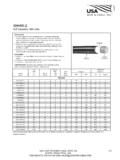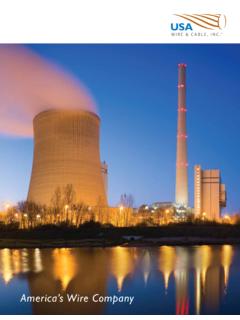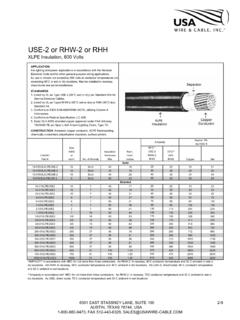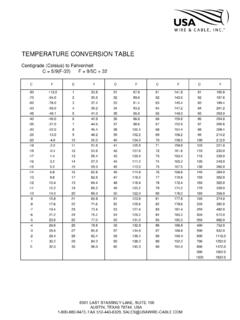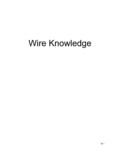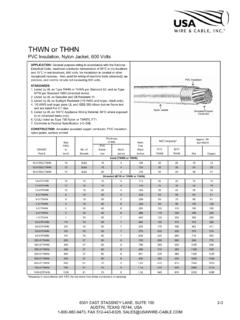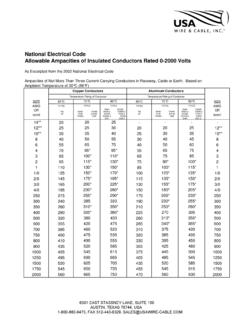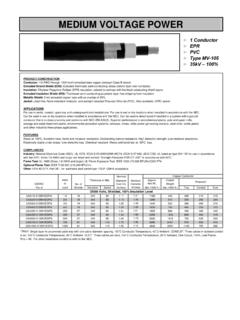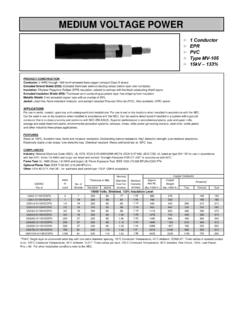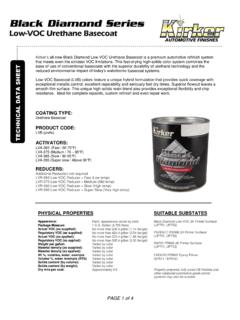Transcription of COMPLETE CATALOG PRINTED UPDATED 11 06
1 wire Knowledge W-1. Stranding Comparison W-2. Conductor Coatings/Coverings PURPOSE. To facilitate stripping of components applied over the conductor To prevent compound fall-in Improve solderability Prevent Incompatibility Issues Provide electrostatic shielding for overlying insulation TYPES. Electroplate or Hot Dip Tin Alloy Metallic Coating Mylar (Opaque), Polyester or Paper Tape Extruded Semi-conducting Polymer Shield for MV. Designs W-3. Insulation Types Thermoplastic Definition: A classification for a solid insulation material that can be softened and made to flow by heating, extruded onto wire and quenched in cool water to make solid again.
2 It can readily be softened and re-softened by repeated heating, but remains in a safely usable solid form when operated within its rated temperature limits. Normal Types Temperature Rating High Molecular Weight Polyethylene HMPE 75o PolyVinyl Chloride (PVC) 60o, 75o, 90oC. Polypropylene 80o Tefzel 150o Teflon 150o or 200oC. W-4. Insulation Types Thermoset Definition: A classification for an insulation that is extruded onto wire and then, when subject to heat and pressure, undergoes a chemical change known as vulcanization, cross-linking or curing.
3 The process fixes (sets) the physical properties of the material so that if it is again exposed to heat, the material will not melt, flow or drip. Normal Types Temperature Rating XLPE 90oC. XLPO (LSZH) 90oC. FR-EP 90oC. Silicone Rubber 125oC. Hypalon (Chlorosulfonated Polyethylene) 90oC. W-5. Insulation Types Thermoset (Cont.). The preceding insulations are typically those used for low voltage applications (2000V or less). Listed below are insulations that are currently used in medium voltage (2001V and above) applications and high Integrity, low voltage cable designs.
4 Normal Types Temperature Rating Cross-linked Polyethylene (XLPE) 105 C. Ethylene-Propylene-Rubber (EPR) 105 C. Ethylene Propylene Polymer (EPM) 105 C. Ethylene Propylene Diene Polymer (EPDM 105 C. Ethylene Alkene Co-Polymer (EAM) 105 C. W-6. Insulation Types Thermoset (Cont.). Thermoset insulations normally include a chemical catalyst additive such as sulfur or peroxide that provides the means for cross-linking of the material on the molecular level. Heat kicks off the cross-linking process and pressure is required to prevent bubbles/voids from forming due to out-gassing that occurs during the process.)
5 Following are processes typically used to make a material thermoset: x Pressurized high temperature steam or Nitrogen cure (CV-Continuous Vulcanization). x Lead or polymer mold - steam autoclave cure x Moisture catalyst cure/cross-linking x High energy electron beam cross-linking W-7. Jackets PURPOSE. To protect the underlying cable core from mechanical, moisture and chemical damage during the installation and service life of the cable Enhance flame resistance Improve sunlight and electrical surface tracking resistance Facilitate installation Provide means for cable identification and grouping W-8.
6 Types of Jackets Thermoplastic Polyvinyl Chloride PVC. Polyethylene PE. Nylon (Polyamide). Chlorinated Polyethylene CPE. Thermoplastic Polyolefin TPO. Thermoset Neoprene (Polychloroprene) CR. Hypalon (Chlorosulfonated Polyethylene) CSPE, CP. Nitrile / PVC (Blend of Nitrile Rubber & PVC) NBR/PVC. Chlorinated Polyethylene CPE. Cross-linked Polyolefin XLPO. W-9. Single Conductor 600 Volt Cables THW THHN / THWN XLP-XHHW EPR HYPALON. Supply Problem Stock Stock Stock Lowest Cost Low Cost-Circuit Sizes Low Cost-Large Sizes Highest Cost 75oC 90oC / 75oC 90oC 90oC / 75oC.
7 Colors Colors Colors Black Only Larger OD Small OD Small OD Larger OD. Fair Electricals Fair Electricals Good Electricals Good Electricals Good Moisture Res. Good Moisture Res. Excellent Moisture Res. Excellent Moisture Res. Pulls Easy Pulls Easy Pulls Easy Pulls Harder Good Flame Res. Good Flame Res. Poor Flame Res. Good Flame Res. Good Oil Res. Good Oil Res. Poor Oil Res. Good Oil Res. Good Chemical Good Chemical Good Chemical Good Chemical Poor Low Temp. -10oC(+14o) Poor Low Tep. -10oC (+14o) Excellent Low Temp. Good Low Temp. W-10.
8 Single Conductor Assemblies Tray Cable & Interlocked Armor WHY USED: Lower installed cost system compared to pipe & wire COMPLETE system installed at one time Accidental installation damage easily found and repaired when installed in tray Easier/cheaper to accommodate future changes in branch circuits/taps when installed in tray Same cable can be used in wide variety of installations tray, duct, conduit, aerial or direct buried Jacket on UL Type TC (Tray Cable) and Armored (UL Type MC) provides mechanical, moisture and chemical protection during installation Greatly enhanced flame retardant system W-11.
9 Tray Cable & Interlocked Armor Comparison TRAY CABLE INTERLOCKED CABLE. Lighter More Rugged Easier To Install Better Flame Lower Cost Color Coding / Phase Identification Color Coding Methods (8 total). o Method 1 Full Colored Phase Conductors o Method 2 PRINTED Numbers & Color (1-Black). o Method 4 Black Phase Conductors With PRINTED Numbers (1-One). NEC Requirements ICEA Standard Color Coding Tables (7 total). Table E-2 for NEC Applications (ICEA S-73-532). W-12. Tray Cable & Interlocked Armor WHERE USED: In Industrial Establishments In Process Industries: Petrochemical Pulp & Paper Chemical Plants Automotive Steel Mills Cogeneration Waste Water Treatment On Cable Tray Support Systems Some Usage In: Conduit Direct Burial Underground Duct Aerial Messenger Supported W-13.
10 Medium Voltage Cable 2001 Volt Through 35kV. MEDIUM VOLTAGE CABLE: Cables having a voltage rating of 2001. volts and higher CONSTRUCTION COMPARISON: BASIC CABLE. 600V MV. Conductor Conductor Insulation Conductor Shield Jacket (optional) Insulation Insulation Shield (5kV-35kV). Jacket DEFINITION OF SHIELDING: Shielding of an electric power cable is the practice of confining the electric field of the cable within the insulation surrounding the conductor. It is accomplished by means of semiconducting conductor shield and, semiconducting insulation shield that is in combination with an overlying metallic shield W-14.
